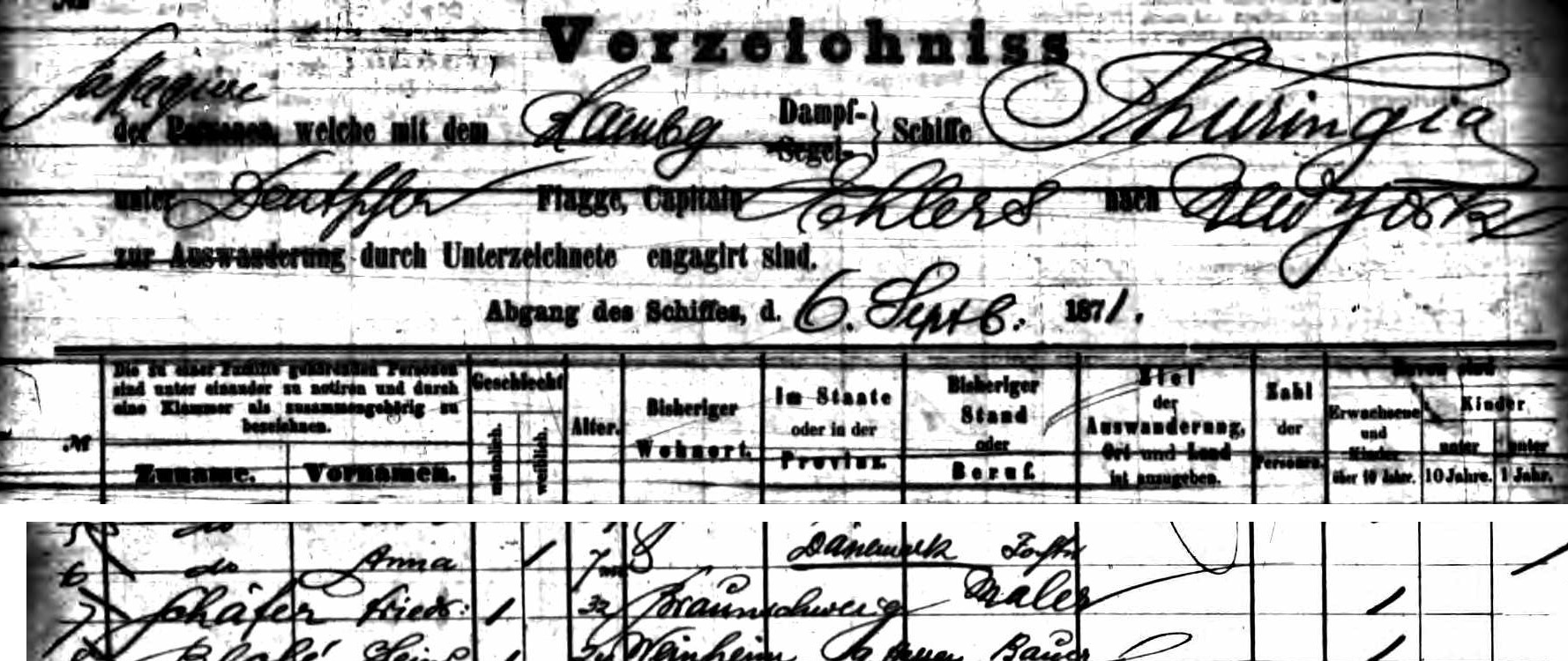Travels of the artist
Note: The travels described in this section are also listed, in briefer form and without supporting links and citations, in the Chronology of events in Schafer's life.
The sites depicted in Schafer's paintings imply extensive travel. Although no explicit record of his travels has come to light, between the locales he painted, newspaper articles mentioning his comings and goings, and advertisements of sales, we can reconstruct at least some of his itineraries. (This exercise requires assuming that he actually visited most of the places he painted, rather than relying on photographs or renderings of other artists. As will be seen, there is some evidence that this assumption is not always safe.)
Europe
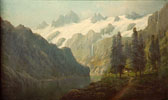 |
| In the Swiss Alps |
The only traces of a presence as a painter in Europe before emigration to the United States that have been uncovered so far are four paintings titled as Swiss or Alpine mountain scenes and one with a verso title in German.1 The small number of identified European paintings is a bit puzzling, since Schafer emigrated to the United States at the age of 32. It could indicate that he began his career as an artist late, or perhaps just that he found no success in Europe.
Emigration
Direct evidence of Schafer's emigration to the United States has not been located, but there is moderately convincing indirect evidence.2 In the image below, a passenger whose name is recorded as Friedr. Schäfer embarked at Hamburg on the S.S. Thuringia, leaving for New York City on September 6, 1871. The passenger gave his age as 32, his occupation as painter, and the city where he previously resided as Braunschweig, in Germany. The passenger's name, after anglicization, matches that of the artist Frederick Schafer, the age matches his known year of birth, and the previous city of residence matches that reported by his grandson. The September 19 arrival manifest of the Thuringia at New York City lists the same passenger.
Outgoing passenger manifest of the S.S. Thuringia, September 7, 1871, at Hamburg, Germany.
Click on the image to see the full manifest page.
It is not known whether this voyage was just one of several to America made by Schafer, though ship passenger indexes from that era do not appear to reveal any other voyages to or from Europe. (One should also keep in mind the possibility that by coincidence the 1871 passenger is actually an unrelated house painter named Friedrich Schäfer from Braunschweig who happened to be born in the same year as the artist.)
Move to California
A press dispatch, with versions published in the New York Times, the San Francisco Evening Bulletin, and the San Diego Union, reports that on March 23, 1873, a Frederick Schafer, his wife, and one child boarded the coastal steamer Henry Chauncey in New York City, bound for San Francisco by way of Panama. 3 Although this family may be that of the artist, the information in the dispatch is not sufficient to be sure (in that era several different Frederick Schafers appear in the city directories of both New York City and San Francisco), so associating this sailing with the artist is a conjecture.
The dispatch indicates that the family crossed Panama by rail and boarded the coastal steamer Great Republic, which continued the trip from Panama City to San Francisco. That ship was scheduled to call at the ports of Acapulco, Mazatlan, and Cabo San Lucas, Mexico. Those three stops could explain the titles of five paintings: Sunset on Cape St. Lucas, Pacific Ocean, Moonrise near Acapulco, and the (currently unlocated) paintings Mazatlan, which was exhibited as painting #127 at the Mechanics' Institute Fifteenth Industrial Exhibition in 1880, Coast Scene near Acapulco, Pacific Coast, offered as lot 6 in an auction in Salt Lake City in 1886, and On the Coast of Mexico, offered as lot 28 in an auction in San Francisco in 1885. According to an arrival report in the newspaper (San Francisco) Daily Alta California, the Great Republic with the Schafer family aboard docked in San Francisco on April 21, 1873.
Contradicting this conjecture, Dwight Miller reports that in 1879 Schafer's wife and son Otto joined him in San Francisco.4 That report suggests that Schafer may have made a trip east to pick them up during the summer, and it would explain why the earliest appearance of paintings with east coast titles in west coast exhibitions is in the fall of 1879. That report may be based on the 1924 death certificate of Schafer's wife Sophie Braun Schafer, which states that she had been resident in California for 45 years.
In any case, Schafer was in San Francisco by October 1876, when an advertisement appeared for a sale there that included his paintings. That sale advertisement is the earliest compelling documentation so far discovered of Schafer's presence in San Francisco.  On the Passaic River, New York |
West coast travels
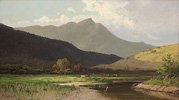 Mount Tamalpais from Ross Valley, California [2] Mount Tamalpais from Ross Valley, California [2] |
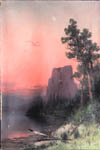 Evening on Castle Rock, Columbia River [1], 1884 Evening on Castle Rock, Columbia River [1], 1884 |
Schafer apparently spent part of the summer of 1885 on a visit to Victoria, British Columbia. Several reports in (Victoria, British Columbia) The Daily Colonist describe a June exhibition of his paintings and a catalog of a July auction there of 60 paintings includes a helf-dozen scenes in and around Victoria. Later that summer, perhaps on the way home to San Francisco, there were at least two similar exhibitions and sales of his paintings in Portland, Oregona, the first in August as reported by (Astoria, Oregon) The Daily Astorian and the second in October as reported in the (Portland, Oregon) Evening Telegram.
 Salt Lake City, Utah, Morning |
Although no confirmation has been located of a trip, from the state of construction of the buildings, the scene at the right of Salt Lake City must have been sketched or painted in 1883 or 1884.7 The earliest newspaper report of a visit to Salt Lake City is two years later, in May of 1886.
In January 1886, Schafer traveled to Los Angeles to sell paintings and to sketch local scenery. Newspapers reported his presence (and dismal sales) for at least two weeks. He returned to Los Angeles in December of that year for a longer visit that began that month with an exhibition followed by two auctions, one in December 1886 and a second in early February 1887. A half-dozen paintings of southern California scenes, including the cityscape Chinatown, Los Angeles, 1886 and at least two paintings of Mount Baldy, west of Los Angeles, may have came out of these trips.
Newspaper notices and auction advertisements from 1884 through 1887 often claimed that the artist was about to depart for Europe. See, for example, mentions of an imminent departure in the San Francisco Evening Bulletin of 15 September 1884, again in (Victoria, British Columbia) The Daily Colonist of 13 June 1885, the (Portland, Oregon) Evening Telegram of 12 August 1885, the Los Angeles Herald of 13 February 1886, the Los Angeles Herald of 12 December 1886 (which also mentions a planned visit to Central America), and the Sacramento Daily Record-Union of 12 April 1887 (which anticipates his departure "…for Europe in a few days.") However, apart from these notices no evidence has yet surfaced of any such trip.
Late in his career, in 1914 Schafer made several visits to La Grange, California, to make sketches for his painting of the [La Grange Dam] (provisional title), which was to be exhibited in the Stanislaus County section of the California Counties Building at the 1915 Panama-Pacific International Exposition.
Ventures farther inland
A brief note in the "Art Notes" section of (Chicago) The Sunday Inter Ocean in 1888 found Schafer exhibiting in that city. It is probably not a coincidence that his presence in Chicago coincided with the First Annual Exhibition of American OIl Paintings of the Art Institute of Chicago, but the catalog of that exhibition8 does not list any of Schafer's work. He later held his own gaslight exhibition, his "best productions of the last eight years". The following week the same paper reported that he had sold 35 of 157 paintings. These sales are probably the source of the several paintings that have emerged in the Chicago area. Two months later, in August, the (Denver) Rocky Mountain News reported him in Denver, where he exhibited 71 paintings, presumably on the way home from Chicago. If that assumption is correct, 51 paintings that he took on that trip are unaccounted for.
Several paintings have been found of scenes of Great Plains Indians, two of which have Montana in their titles, and others, by appearance, from the same locale. There are four Colorado scenes, two Idaho scenes (and an unverified report of others,6) ten in Utah, one in Nevada, at least nine in British Columbia, and one in Alaska. The Alaska scene, one Idaho scene, and one Colorado scene are dated 1889, suggesting an extensive trip north and inland that year.
A series of newspaper reports and auction advertisements in the The Seattle Post-Intelligencer in May and June 1890 chronicle a visit to Seattle, Washington, to set up a teaching studio and exhibit and sell "over one hundred" of his paintings. Apparently Schafer's intent to set up a studio there did not materialize. According to William K. Dick the Seattle library did not find confirming information in the city directories of that period.
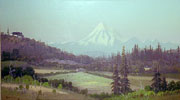 View from Beacon Hill, Victoria, British Columbia |
Immediately thereafter, in December 1891, the (Salt Lake City) The Herald and the (Salt Lake City) Daily Tribune published at least eleven articles chronicling a visit, a studio, an exhibition and several days of sale of ninety paintings. Again the paintings did not sell for good prices.
From the newspaper accounts, the visits to Seattle, Santa Cruz, Vancouver, Ogden, and Salt Lake City were each week-long events consisting of a newspaper publicity campaign announcing a gaslight exhibition and plan to open a teaching studio, followed by several days of auction sales conducted by San Francisco auctioneer C.P. Troy. In addition, a few paintings were given away each sale day in a drawing for customers who arrived at the exhibition before the sale started. The unconfirmed report mentioned earlier that Schafer had a studio in Portland may be based on a similar event.
Nearly all Schafer landscapes are summer scenes, probably because the territories depicted were difficult to visit in the winter.9 The address of Schafer's studio changed almost every year that he had a studio in the artists' quarter of San Francisco.5 The yearly address changes, taken together with the evidence of travel and the predominance of summer scenes, suggests that he spent the summers from 1880 to 1892 traveling and sketching throughout the West, and rented available winter studios until he moved his studio into his home in 1887.
Non-travel
 [Scene in Guatemala] |
One must exercise some caution in assuming that a painting implies a visit since there are some fairly compelling counter-examples. The jungle landscape [Scene in Guatemala] comes with a legend that it was painted as a memorial commission;10 the similar [Tropical sunset] and [Tropical scene 1] may have been painted in response to a demand, arising among pre-railroad Californians, for souvenirs of the Panama route that some of them had travelled from the eastern United States. Finally, as mentioned earlier, the existence of a painting titled Mazatlan has led to an open question about whether or not Schafer's original arrival in California was by coastal steamer via Panama.
 Chimney Rock, Hickory Nut Gap, by Harry Fenn | 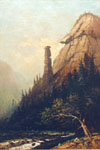 Chimney Rock, French Broad Region, West Carson |
Also, landscape photography was a rapidly developing art at the time and several leading landscape photographers of the day made San Francisco a base for photographing many of the same grand vistas that Schafer painted.11 Landscape painters sometimes used these photographs as a supplement or even as a complete replacement for field sketches, and there is even a newspaper report that Schafer exhibited his own photographs. Caution is thus required in deducing Schafer's travel patterns from the painting subjects alone. For example, Chimney Rock, French Broad Region, West Carson in North Carolina bears a striking resemblence to a wood engraving by Harry Fenn that appeared in the book Bryant, William C., editor, Picturesque America. Since there is no other evidence that Schafer ever visited North Carolina, it seems safe to assume that this painting was done from the engraving. Similarly, [Mountain of the Holy Cross 2] appears to be a composite of a photograph of the mountain by William Henry Jackson and a widely circulated chromolithograph of a painting by Thomas Moran (which itself may have benefited from the photograph).12 Again it seems likely that this painting was done without visiting the actual site.
These sparse facts and reports leave the art historian with more questions than answers. Perhaps this brevity of history is a virtue, because it means that analysis of Schafer's work must be performed with reference only to the art itself. That analysis is the topic of the next section.
1. The five European paintings are In the Swiss Alps, Swiss landscape [1], [Swiss landscape 2], [Alpine scene], and Morgen im Walde (Morning in the woods [1]). There are also two unlocated titles which suggest European sites, Alpine glow and Sunset in the Swiss Alps.
2. I am indebted to James Marquardt for tracking down in genealogical resources the information regarding Schafer's immigration to the United States and possible travel from New York to California via Panama.
3. The dispatch reports that the steamship sailed for "Aspinwall", a name once used by Americans for the Atlantic port city of Colón, Panama. The complete route from New York to San Francisco via Panama that the family will follow and the ports of call along the way are described in a departure advertisement of the Henry Chauncey placed by the Pacific Mail Steamship Company in the New York Herald.
4. See page 48 of the notes for the exhibition California Landscape Painting, 1860–1885. Miller does not give a source for this report; it can probably be traced to the 1975 interview by William K. Dick of Schafer's grandson Frederick O. Hughes.
5. Langley's San Francisco Directory lists the following addresses for Frederick Schafer, presumably studios:
| Before 1880 | (Not listed.) |
| 1880 | 432 Montgomery St. |
| 1881 | 432 Montgomery St. |
| 1882 | no listing |
| 1883 | 211 Sutter (under "Painters–portrait, etc.) 327 Dupont (in the listing by name) |
| 1884 | 1266 Kearny, room 39 |
| 1885 | 217 Phelan Building (886 Market Street) |
| 1886 | 506 Battery |
| After 1886 | (Not listed. In 1887 a different Frederick Schaefer is listed under "Painters–House". |
6. In a 1990 telephone conversation, collector Franz R. Stenzel (1906–1998) mentioned Schafer's Portland studio and that he once located someone who claimed to be the daughter of Schafer's Portland landlady. However, William K. Dick found no evidence of a studio in either the Portland or Seattle city directories (William K. Dick notes, pages 26 and 28). Dr. Stenzel listed Idaho as a locale appearing in verso inscriptions on page 22 of the notes for the 1963 exhibition An Art Perspective of the Historic Pacific Northwest. In that same telephone conversation, Dr. Stenzel could not recall where he saw the Idaho paintings, but suggested that it was probably in a Portland antique store. The two Idaho paintings in this inventory have been in private collections located far from Portland since 1890, where it is unlikely that they would have been encountered by Dr. Stenzel. Thus there probably are more Idaho paintings that have not yet been catalogued.
7. According to the notes by Linda Jones Gibbs in the catalog of the 1985 exhibition Masterworks from the Collection of the Church of Jesus Christ of Latter-Day Saints.
8. The list of paintings is in the Art Institute of Chicago, Catalogue of the First Annual Exhibition…. According to the review in The Sunday Inter Ocean (Chicago) there was also a side exhibit of some 500 paintings (described as "oily horrors") that were not accepted for the exhibition. A list of paintings in the side exhibit has not been located, so it is not known whether any of Schafer's work appeared there.
9. Only nine paintings depicting snow have emerged, four of which are set in the desert (e.g., [Indians traveling on horseback through the snow]). Two paintings, After a snowstorm in the Sierra Nevada Mountains near Summit Station, Central Pacific Railroad and Winter in the Sierras on the Central Pacific Railroad, both appear to be winter scenes, but the amount of snow is actually more appropriate for late autumn at that altitude.
10. Reported in the catalog for the 1971 exhibition Tropical Scenes by the 19th Century Painters of California, page 45.
11. Cock, Elizabeth M., The Influence of Photography on American Landscape Painting, 1839–1880, Ph. D. Thesis; Naef, Weston J., Era of Exploration.
12. I am indebted to Ray Castello for locating and bringing to my attention the Harry Fenn engraving of Chimney Rock. The suggestion that Schafer's paintings of the Mountain of the Holy Cross might be derivative comes from Trenton, Patricia and Peter H. Hassrick, The Rocky Mountains, pages 155 and 170 and plate 60.
